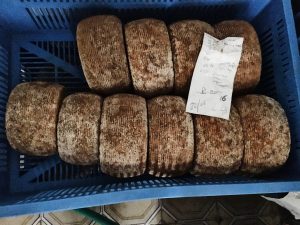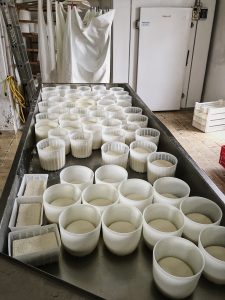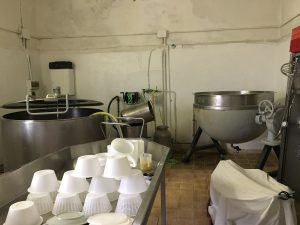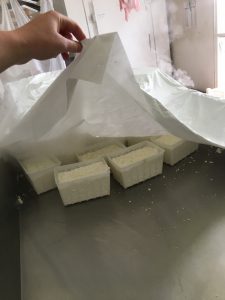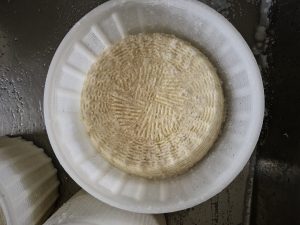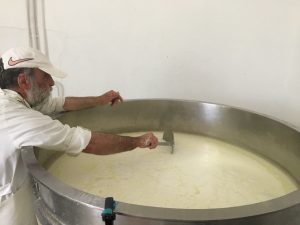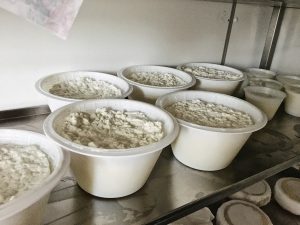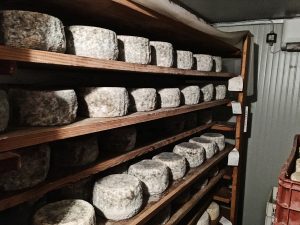I love cheese. I love thinking about it, I love eating it, I love going to the grocery store to buy cheese, or better yet to a farmer’s market. I love bringing cheese to parties and making a personal cheese board after a long day. Thus, after being a longtime fan of this food I’ve often dreamt about learning how to make it, which has been a part of human’s cuisine for thousands of years. Now I am fulfilling this dream by learning how to make cheese in one of the countries that is most famous for its cheeses! Dreams do come true, don’t let anyone tell you otherwise.
Claudio Cavazzoni makes cheese once a week, every Wednesday, except for the third week of the month when splits the work between Wednesday and Friday. This is because every third Sunday of the month he attends the Fierucola market in Florence. The process takes about seven hours to make the magical transformation from a liquid to a solid, and seven different types of solid I might add. The milk must be warmed to begin, and because this is the EU and not the US the milk is unpasteurized, this is unadulterated, raw milk. It just needs to be a warm enough temperature so that the cultures added will be able to grow rapidly, ferment, and add a variety of flavors to the cheese. Claudio separates the milk into a few containers to differentiate the types of cheese that is to be made, and sets aside one small (ish) vat for yogurt. Each type of cheese gets a different species of bacteria because each species produces a distinct flavor, and over the years Claudio has found which species he prefers for each type of cheese, though don’t ask him for their names because he doesn’t know. He’s been doing this for 30 years, give him a break people! When he first started he was doing a sort of natural fermentation, that is using the bacteria that exists in the environment on the farm, but doing this makes for less consistent cheese, and if you’re trying to run a business naturally fermented cheese can be risky. Customers get used to expecting a certain flavor from you cheese as well as consistency in texture, and you have no way of knowing for sure what type of bacteria decided to make your cheese it’s home, so it’s much safer to buy the cultures and inoculate the milk.
The story goes that humans discovered how to make cheese by accident, thousands of years ago. When people were traveling from one place to another they would carry their water and milk in the stomachs of cows, and the rennet (an enzyme found in the stomach of mammals) would curdle their milk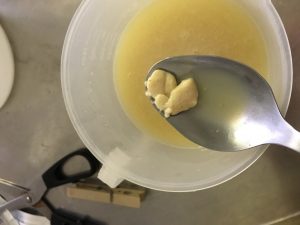 and when they ate it they realized how delicious it was, so they started making it intentionally. In today’s standards of cheese making the rennet is added after the cultures, the most important enzyme in rennet is chymosin, or rennin, because it gives the casein protein a sort of haircut by lysing the ends of the protein bundles (micelles), making these negatively charged proteins that usually repel one another come together to form a meshwork of proteins, which is what is happening when the milk begins to coagulate. It takes about 20 minutes for the milk to start forming a soft solid, and once it reaches this state it’s time to cut the curd to begin to extract the water molecules between the proteins. After the curd is cut it is then stirred to create even smaller curds and then scooped into plastic cheese baskets. There are a few different types of baskets used depending on the destiny of the cheese, for pecorino fresco the baskets have small holes to retain more water, while pecorino semistagionato and stagionato (semi aged and aged) have baskets with wider slits to more water to escape.
and when they ate it they realized how delicious it was, so they started making it intentionally. In today’s standards of cheese making the rennet is added after the cultures, the most important enzyme in rennet is chymosin, or rennin, because it gives the casein protein a sort of haircut by lysing the ends of the protein bundles (micelles), making these negatively charged proteins that usually repel one another come together to form a meshwork of proteins, which is what is happening when the milk begins to coagulate. It takes about 20 minutes for the milk to start forming a soft solid, and once it reaches this state it’s time to cut the curd to begin to extract the water molecules between the proteins. After the curd is cut it is then stirred to create even smaller curds and then scooped into plastic cheese baskets. There are a few different types of baskets used depending on the destiny of the cheese, for pecorino fresco the baskets have small holes to retain more water, while pecorino semistagionato and stagionato (semi aged and aged) have baskets with wider slits to more water to escape.
Once all of the curd is transferred from the vats to the baskets you let the cheese rest underneath a sheet of plastic that has steam hose in it on the stainless-steel table, which is at an angle to allow all of the water and the whey protein that leaves to cheeses to flow down into a hole that has a bucket placed underneath to catch all of this runoff. The whey runoff will be saved to make ricotta later, but we’ll get to that.
It only takes about 30 minutes for the cheese to begin to set in the basket, at this point you start turning the cheese and stacking the aged cheeses on top of each other to press more water and whey out of the curd. You turn the cheeses about four times, giving 20 minutes of rest between each turn. Once the cheese has gone through this process, so about 4 hours after being placed in the basket, it’s time to give those wheels a good salt rub. Each wheel is rubbed thoroughly with salt and is placed back into the basket to sit for another 12-24 hours depending on the size. I love this part because after you wash the salt off of your hands they are so soft. After all of this it’s time for lunch, so we eat a nice meal, have a bit of a siesta and then return to finish for the day.
Now it’s time to for ricotta to shine, all of the whey that was collected goes through about six or more filters between large vats using cheese cloth and a pump to make sure that there is no curd left. Once it has been sufficiently filtered the whey goes back into this giant vat that is then heated until the whey starts to coagulate. Once the coagulation occurs we take giant ladles and distribute them into the appropriate number of baskets. This ricotta is so good, I cannot explain how much I love the ricotta at Il Campriano. I will have dreams about it for the rest of my life.
Now back to the fresco and the stagionato cheeses, it’s time to wash those babies. Each wheel is given a rinse with water to get rid of the salt and is taken out of the basket and left on the table for one day. Pecorino fresco is place in a refrigerator after one day while the stagionato cheeses are transferred to clean wooden boards that are placed on top of the table for another day before being transferred to the cave. There they are aged for about 4 months (semi stagionato) to about one year or more (stagionato). The cave is essential for the aging process of chees, it can’t be too cold or too warm in order to have the perfect fermentation for flavor. The ideal temperature is about 52 degrees Fahrenheit (11 degrees Celsius), but can be between 60-37 (16-3). When the cheese is still very young it’s important to turn it every day, or every other day, otherwise it will stick to the board. After it’s had some time in the cave you turn them less frequently, maybe every three days. Once a month has passed they are transferred to plastic crates to make room for the new cheese, and there they are turned even less frequently.
The cheese making process really does feel like magic, of course it’s not magic, it’s microorganisms that are doing all of this work to make cheese so delicious and desirable by all. Even vegans attempt to recreate the wonders of cheese, but there has yet to be a substitute that even comes close to the real deal. I’m very fortunate to be in the minority of folks who have the lactase enzyme, and I’m not sure that I would be able to give up cheese if I didn’t, fortunately this thought is trivial and I will continue to eat my way through all varieties of cheese. This is beside the point. I probably could have dedicated my entire quarter to cheese making because there are so many things involved in this process. I barely talked about proteins, which I cannot express enough how much I love proteins, ask anyone that I know, I love polypeptides. Alas, I just wanted to give a brief run through of the process I’ve experienced during my stay at Il Campriano. If you’re interested in learning more about the science of making cheese I suggest reading On Food and Cooking by Harold McGee, it’s like a food science bible, one that I wish I brought on my trip, but I constantly refer to for any food related science inquiry.
Though my stay at Il Campriano has come to an end, I am so excited to bring this new-found passion and skill with me back to my life in the States, I’m planning on setting aside a few days each month to make my own cheese at home, and pecorino specifically. United States cheese eating citizens need to eat me pecorino, let’s make it a thing. Shout out to Black Sheep Creamery for going strong in Chehalis, WA. Until I can come back and tell the nation about the wonders of sheep cheese, I’ll just enjoy the pecorino that Claudio gave me as a parting gift from his farm.
Ciao ciao for now!
